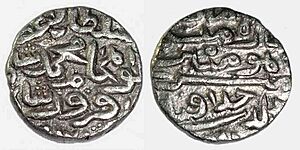Khizr Khan facts for kids
Quick facts for kids Khizr Khan |
|
|---|---|
| Sultan | |

Silver Tanka of Khizr Khan INO Muhammad Bin Firoz
|
|
| 25th Sultan of Delhi | |
| Reign | 28 May 1414 – 20 May 1421 |
| Anointment | 28 May 1414 |
| Predecessor | Nasir-ud-Din Mahmud Shah Tughluq |
| Successor | Mubarak Shah |
| Under the nominal suzerainty of | Shah Rukh Mirza |
| Timurid Governor of Multan | |
| Reign | 17 December – 20 December 1398 |
| Timurid Governor of Delhi | |
| Reign | 20 December 1398 – 18 February 1405 |
| Anointment | 21 December 1398 |
| Under the nominal suzerainty of | Timur |
| Born | 1351 |
| Died | 20 May 1421 (aged 70) |
| Burial | Delhi, India |
| Issue | Sayyid Mubarak shah |
| House | Sayyid dynasty |
| Religion | Islam |
Khizr Khan was a very important ruler in India. He founded the Sayyid dynasty, which was the fourth ruling family of the Delhi Sultanate. This happened in northern India after a big invasion by Timur and the end of the Tughlaq dynasty. Khizr Khan ruled from May 28, 1414, to May 20, 1421.
Before becoming a sultan, Khizr Khan was the Governor of Multan. He served under the Tughlaq ruler, Firuz Shah Tughlaq. People knew him as a very skilled leader. He chose not to use a royal title like "Sultan." This was because he respected Amir Timur, also known as Tamerlane. Instead, he used titles like Rayat-i-Ala (Sublime Banners) and Masnad-i-Aali (Most High Post). Even during his rule, coins still showed the names of earlier Tughlaq rulers. After he passed away on May 20, 1421, his son, Mubarak Khan, became the new ruler. Mubarak Khan then took the title of Muizz-ud-Din Mubarak Shah.
Who Was Khizr Khan?
Some writers from Khizr Khan's time believed he was a descendant of Muhammad. The Sayyid dynasty claimed this connection through Muhammad's daughter, Fatima. However, modern historians have different ideas. Some think his family might have been Arab settlers in Multan. Others suggest he was a Punjabi chieftain from the Khokhar clan. He might have even been an ambassador to Timur before he became powerful in Delhi.
Khizr Khan's Rule
When Khizr Khan became ruler, he made Malik-us-Sharq Tuhfa his chief minister, or wazir. This minister was given the special title of Taj-ul-Mulk. He stayed in this important job until 1421. Khizr Khan also gave out land areas, called fiefs, to his trusted officials. For example, Sayyid Salim received the areas of Muzaffarnagar and Saharanpur. Abdur Rahman was given the fiefs of Multan and Fatehpur.
Important Events During His Reign
In 1414, an army led by Taj-ul-Mulk went to stop a rebellion. This rebellion was started by Har Singh, the Raja of Katehar. Raja Har Singh tried to hide in the forests. But he eventually had to give up and agreed to pay taxes in the future.
In July 1416, Taj-ul-Mulk led another army. This time, they went to Bayana and Gwalior. They collected money from the local people, saying it was for tributes. They also took control of both these regions. In 1417, Khizr Khan received special permission from Shah Rukh. This allowed him to add his own name to Shah Rukh's name on official documents.
In 1418, Raja Har Singh rebelled again. But Taj-ul-Mulk's army completely defeated him this time. Finally, on May 28, 1414, Khizr Khan successfully took control of Delhi. He also imprisoned Daulat Khan Lodi, a previous ruler.

